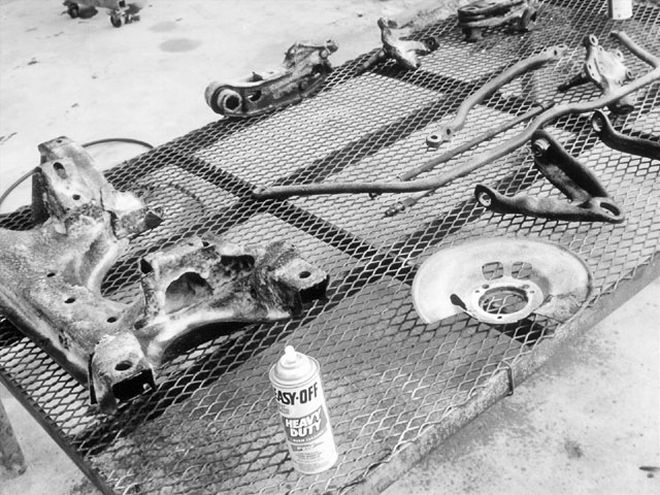
 The first job after the suspension is disassembled (Mopar Muscle Feb '01) is to clean the muck. Caustic oven cleaner was used to soften the grease and grime, and the parts were rinsed, then blasted with a pressure washer. This resulted in relatively clean components, and preserved the original finishes and paint daubs. The finishes and paint daubs were recorded and photographed for reference, though we didn't recreate the factory production daubs in this rebuild.
The first job after the suspension is disassembled (Mopar Muscle Feb '01) is to clean the muck. Caustic oven cleaner was used to soften the grease and grime, and the parts were rinsed, then blasted with a pressure washer. This resulted in relatively clean components, and preserved the original finishes and paint daubs. The finishes and paint daubs were recorded and photographed for reference, though we didn't recreate the factory production daubs in this rebuild.
Pure resto or modified? It's a recurring question when building an older Mopar, applying as much to the chassis components as it does under the hood. But what's stock? Frankly, taking the purist stance to the extreme, only an untouched factory-built car is truly stock; anything touched by human hands thereafter is an interpretation of what stock appearance was. While the high end of the resto hobby has come to some generally accepted interpretations of what stock is, bare metal, cosmoline grease, and dipped torsion bars are really just an interpretation of the hobby's current beliefs of what it was like in the day. We see lower control arms dipped just short of the ball joint in black paint, highly defined between the unpainted bright bare-metal end and the glossy black section. Was the reality more like surface rust over the bare metal where the damp air could take its toll? A rough and smeared black portion where a gloved hand grasped a still tacky control arm and tossed it on a rack or pallet? These questions are likely to never be answered.
One thing that's certain is that current state-of-the-art in concours suspension detailing leads to a highly defined and attractive underchassis. At the national event level for judged show competition, achieving the state-of-the-art interpretation of stock requires that the finish be created by duplicating, as accurately as possible, the surface finish accepted as original. Bare metal should be bare metal, cosmoline grease should be actual grease, and all of the parts should be NOS or at least accurate reproductions. While this approach is appropriate for the show field, on the street there are the added constraints of functionality and durability.
Bare metal and grease were never meant to last, and for a real-world street driver this may not be a practical approach. A second aspect has to do with parts selection. Achieving truly authentic resto-detailing rules out the use of upgraded components such as modern shocks, polyurethane bushings, or even operating grease zerks in the ball joints and steering linkage. Most commonly available replacement parts are also visibly different than the OEM parts of old, notably the rubber dust boots supplied with replacement tie-rod ends.
Where does that leave the enthusiast? For a street buildup, like in a true concours buildup, the suspension detailing comes down to the builder's interpretation of what the suspension should be. Unlike the pure resto build, building a car for the street allows more latitude in the selection of components. This suspension for an original '70 Dodge Dart Swinger 340 was done with functional improvements as part of the plan, including modern gas shocks and polyurethane bushings. The purist stock resto route is blown right there. A street chassis needs regular lubrication, so functioning grease zerks would be fitted, rather than using the now accepted "break-off" zerk plugs. Finally the question comes to finishes. Again, the factory finishes never lasted once the car rolled off the transporter. In the street duty anticipated for this Dart, a bare metal and grease finish would probably be a waste of time, since the elements would undoubtedly ravage this type of detailing effort in a short time. Still, a concours-looking suspension has its appeal, especially when compared to a suspension awash in black.
The goal here was to simulate the factory finishes for a highly detailed resto appearance, make minor performance-enhancing upgrades, and use commonly available aftermarket replacement parts. The parts came in the form of a suspension rebuild kit from Performance Suspension Technologies, with upgraded PolyGraphite bushings in place of the OE replacement rubber. As for the resto finishes, the base materials (DuPont Nason line of urethane) were sourced at a local paint supply jobber. Various blends of aluminum tinting-base, black, clear, and flatting base, along with a few drops of various colored toners, were brewed up at home to create realistic finishes. The finishes were applied over bare metal, using a Binks-type touch-up gun. This imparts the resto-detailed look while giving enhanced performance and the durability to survive street duty.